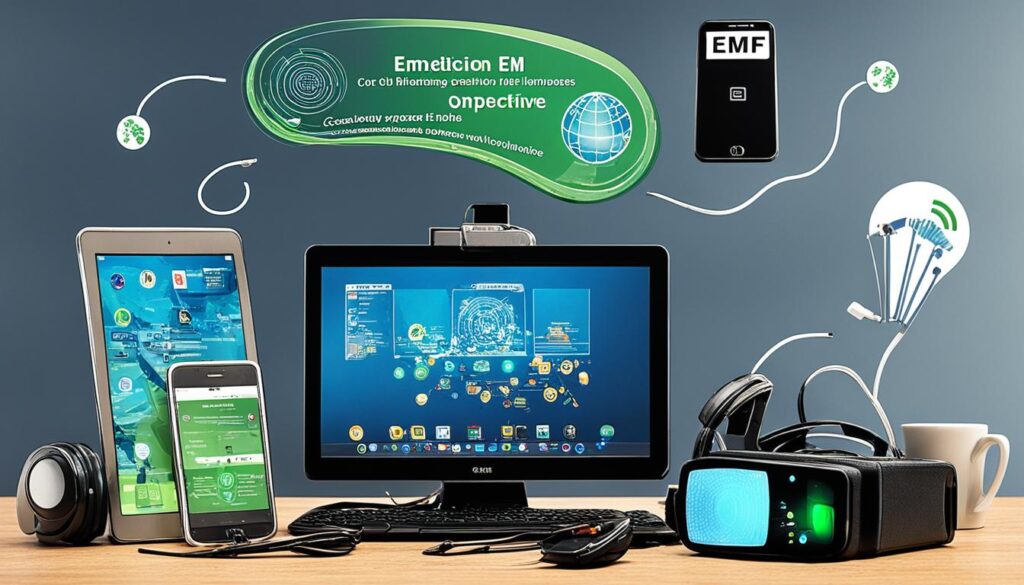Disclosure: This Post Contains Affiliate Links; We earn a commission on purchases.
Electric and magnetic fields (EMFs) are generated by both natural and human-made sources. While most researchers agree that low-frequency EMFs pose little danger to human health, there are still some concerns about potential health effects. EMFs are emitted by common electronic devices such as power lines, cellphones, microwaves, Wi-Fi routers, computers, and appliances. Understanding the different types of EMF exposure and taking necessary precautions is crucial in protecting ourselves and our loved ones.
Key Takeaways:
- EMFs are produced by both natural and human-made sources.
- Low-frequency EMFs are generally considered to have minimal health risks.
- Electronic devices such as cellphones and Wi-Fi routers emit EMFs.
- Understanding different types of EMF exposure is essential for minimizing risks.
- Adhering to safety guidelines can help protect against potential health effects.
Understanding EMFs: Types and Sources
Electromagnetic fields (EMFs) encompass a range of frequencies, varying from high-frequency ionizing radiation that can potentially damage DNA and cells, to low- to mid-frequency non-ionizing radiation deemed safe for human exposure. It is crucial to have a comprehensive understanding of the different types of EMFs and their sources to effectively implement electromagnetic frequency safety measures, adhere to EMF safety regulations, and employ EMF shielding techniques.
High-Frequency EMFs
High-frequency EMFs consist of ionizing radiation, capable of causing damage to biological tissues. This includes x-rays, gamma rays, and certain ultraviolet (UV) rays. Ionizing radiation possesses sufficient energy to remove tightly bound electrons from atoms, leading to the formation of free radicals that can potentially harm cells and DNA.
Low- to Mid-Frequency EMFs
Low- to mid-frequency EMFs are generated by everyday devices and appliances found in our homes and workplaces. They result from power lines, household appliances, and wireless devices such as Wi-Fi routers and cellphones. Unlike high-frequency EMFs, low- to mid-frequency EMFs are categorized as non-ionizing radiation, which means they do not possess enough energy to cause direct cellular damage.
Although extensive research indicates that low- to mid-frequency EMFs pose minimal risk to human health, it is still advisable to be aware of potential sources of EMF radiation and take necessary precautions to reduce exposure levels. Implementing EMF shielding techniques, maintaining safe distances from sources of EMFs, and limiting prolonged exposure to electronic devices are some effective EMF safety measures.
| Type of EMF | Source | Examples |
|---|---|---|
| High-Frequency EMFs | X-rays, gamma rays, certain UV rays | Medical imaging equipment, nuclear power plants, cosmic radiation |
| Low- to Mid-Frequency EMFs | Power lines, household appliances, wireless devices | Electrical wiring, microwave ovens, Wi-Fi routers, cellphones |
Table: Types and Sources of EMFs
Potential Health Effects of EMF Exposure
The scientific community is divided on the potential health effects of EMF exposure. While some studies suggest that there may be a link between long-term, low-level EMF exposure and adverse health effects, others have found no evidence of harm. It is therefore important to be aware of the possible risks associated with EMF exposure and take necessary precautions to protect ourselves.
Common Symptoms of EMF Exposure
- Headache
- Tremor
- Dizziness
- Memory loss
- Loss of concentration
- Sleep disturbance
These symptoms may be experienced by individuals who are more sensitive to EMF radiation. If you’re concerned about your exposure levels or experiencing any of the aforementioned symptoms, it’s essential to consult with a healthcare professional.
EMF Safety Recommendations
To reduce your EMF exposure and promote a safer environment, consider implementing the following tips:
- Keep a safe distance from devices that emit EMFs, such as Wi-Fi routers, cellphones, and microwave ovens.
- Limit your use of electronic devices, particularly when close to your body, such as holding a cellphone next to your ear.
- Use hands-free devices or speakerphone function when making calls on your cellphone.
- Opt for wired connections instead of wireless connections whenever possible.
- Consider using EMF shielding techniques, such as shielding fabrics or cases, to reduce exposure from specific sources.
By implementing these recommendations, you can take proactive steps to minimize your EMF exposure and promote a healthier living environment.
Regulations and Guidelines for EMF Exposure
When it comes to electromagnetic field (EMF) exposure, following the appropriate regulations and guidelines is essential for maintaining safety and minimizing potential health risks. Various organizations and regulatory bodies have established standards to ensure safe EMF exposure levels. These guidelines are based on dosimetric considerations and absorption characteristics of the body at different frequencies of EMFs.
Organizations such as the Federal Communications Commission (FCC), Occupational Safety and Health Administration (OSHA), Institute of Electrical and Electronics Engineers (IEEE), International Commission on Non-Ionizing Radiation Protection (ICNIRP), World Health Organization (WHO), and American Conference of Governmental Industrial Hygienists (ACGIH) have set limits for exposure to radiofrequency (RF) radiation, which is a type of non-ionizing radiation.
Understanding these regulations and guidelines is crucial in ensuring that EMF exposure remains within safe limits. By complying with these standards, individuals can protect themselves from potential health risks associated with prolonged exposure to EMFs.
Regulatory Organizations and Guidelines for EMF Exposure
| Organization | Regulations and Guidelines |
|---|---|
| Federal Communications Commission (FCC) | FCC EMF Guidelines |
| Occupational Safety and Health Administration (OSHA) | OSHA EMF Standards |
| Institute of Electrical and Electronics Engineers (IEEE) | IEEE EMF Standards |
| International Commission on Non-Ionizing Radiation Protection (ICNIRP) | ICNIRP Guidelines |
| World Health Organization (WHO) | WHO EMF Guidelines |
| American Conference of Governmental Industrial Hygienists (ACGIH) | ACGIH Guidelines |
By referring to these regulations and guidelines, individuals can ensure that their EMF exposure remains within safe limits. It is important for both individuals and organizations to stay informed about the latest updates and recommendations from these regulatory bodies to prioritize electromagnetic radiation safety.
Research on EMF and Health Effects
The potential health effects of electromagnetic field (EMF) exposure have been a subject of ongoing research. Studies investigating the possible link between EMF exposure and cancer, including glioma and childhood leukemia, have yielded conflicting results.
Some studies suggest that long-term, low-level exposure to EMFs may have neurological and psychiatric effects. However, other studies have not found any evidence of harm. It is important to note that the research in this area is not conclusive, and further studies are needed to fully understand the potential risks associated with EMF exposure.
Keyword: electromagnetic radiation safety
| Research Findings | Summary |
|---|---|
| Some studies suggest a possible link between EMF exposure and cancer, including glioma and childhood leukemia. | Research indicates a potential association between EMF exposure and certain types of cancer. However, more studies are needed to establish a conclusive relationship. |
| Other studies have not found any evidence of harm from EMF exposure. | Some research has failed to establish a direct correlation between EMF exposure and adverse health effects. However, the interpretation of these findings is still subject to ongoing scientific debate. |
| Research suggests that long-term, low-level exposure to EMFs may have neurological and psychiatric effects. | Preliminary findings indicate a potential association between prolonged exposure to low-level EMFs and neurological as well as psychiatric effects. However, further research is necessary to draw definitive conclusions. |

In summary, while research on the potential health effects of EMF exposure is inconclusive, it is important to remain vigilant and take precautions to reduce EMF exposure where possible.
EMF Protection Tips
- Use wired connections instead of wireless when possible. This includes using a wired internet connection and wired headphones.
- Keep electronic devices away from your body while in use. Avoid holding your cellphone directly against your head and try to use speakerphone or a hands-free device.
- Limit your use of electronic devices, especially at night. Exposure to blue light emitted by screens can disrupt sleep patterns.
- Consider investing in EMF shielding products, such as cases, covers, or shields for your devices.
- Create a technology-free zone in your home, where you can disconnect from electronic devices and reduce your overall EMF exposure.
By implementing these EMF protection tips, you can minimize your exposure to electromagnetic radiation and promote a safer living environment.
EMF Exposure and Mobile Phones
Mobile phones have become an integral part of our daily lives, but concerns about the potential health risks associated with electromagnetic field (EMF) exposure have arisen. Researchers have conducted studies to investigate the possible link between mobile phone use and cancer, particularly glioma.
While some studies have suggested a possible association between mobile phone use and cancer, it is important to note that the overall consensus among experts is that there is currently insufficient evidence to conclude that mobile phone use causes cancer. The World Health Organization (WHO) has classified mobile phone radiation as a “possible carcinogen” based on limited evidence, but more research is needed to establish a definitive link.
Reducing EMF exposure
Despite the lack of conclusive evidence, it is still recommended to take precautions to reduce EMF exposure when using mobile phones. Here are some steps you can take:
- Use hands-free devices: By using hands-free devices such as wired headsets or speaker mode, you can keep your mobile phone away from your body, reducing direct exposure to EMFs.
- Limit mobile phone use: Minimize your overall mobile phone use, especially for extended periods. Taking breaks and using alternative means of communication can help reduce EMF exposure.
- Keep your phone away from your body: Avoid keeping your mobile phone close to your body, such as in your pocket, and instead, place it in a bag or use a belt clip.
It is especially important to be cautious about mobile phone use for children. Their developing bodies may be more susceptible to potential effects of EMF exposure. Encourage children to limit their mobile phone use and advocate for the use of other communication methods whenever possible.
EMF Exposure in the Workplace
Occupational exposure to electromagnetic frequencies (EMFs) is a significant concern in various industries. Certain occupations, such as those working with MRI machines or in industries that use high-frequency EMFs, may have higher levels of EMF exposure. It is crucial for employers and employees to prioritize safety and adhere to EMF safety regulations and guidelines to minimize exposure in the workplace.
Employers play a vital role in ensuring the safety of their workforce. They should implement electromagnetic frequency safety measures and provide appropriate training and education on EMF exposure risks and prevention. This includes proper use of protective equipment and establishing protocols to reduce exposure levels.
Employees can also take steps to reduce their own EMF exposure in the workplace. This includes using EMF shielding techniques, such as metallic screens or barriers, to minimize exposure to high-frequency EMFs. They should also be aware of their proximity to EMF sources and try to maintain a safe distance whenever possible.
Regulations regarding EMF exposure may vary depending on the country or organization. Therefore, it is essential for both employers and employees to stay informed about the specific EMF safety regulations that apply to their workplace. This will help ensure compliance and the implementation of effective safety measures.
Reducing EMF Exposure in the Workplace
Here are some practical tips and recommendations for reducing EMF exposure in the workplace:
- Ensure proper grounding and shielding of electrical equipment and machinery to minimize EMF emissions.
- Use wired connections whenever possible instead of relying on wireless technology, which generates EMFs.
- Position workstations and desks away from EMF-emitting equipment, such as power transformers or heavy machinery.
- Encourage regular breaks and opportunities for employees to move away from EMF-emitting sources.
- Consider implementing a workplace policy that restricts or limits the use of personal electronic devices, such as cellphones, within certain areas.
- Provide training and education on EMF safety measures and encourage employees to adopt healthy habits to reduce EMF exposure.
By following these electromagnetic frequency safety measures and EMF safety regulations, employers and employees can work together to create a safer and healthier work environment with reduced EMF exposure. Prioritizing EMF safety not only protects the well-being of the workforce but also promotes a culture of safety and wellness in the workplace.
EMF and Pregnancy
During pregnancy, it is important for expectant mothers to be mindful of their exposure to electromagnetic fields (EMFs) and take appropriate measures to reduce potential risks. While there is limited research on the effects of EMF exposure during pregnancy, some studies have suggested a possible link between EMFs and adverse pregnancy outcomes, including preterm birth and developmental issues.
Pregnant women are generally advised to minimize their exposure to EMFs by implementing the following EMF protection tips:
- Keep a Distance: Maintain a safe distance from sources of EMFs, such as power lines, electrical appliances, and Wi-Fi routers.
- Use EMF Shielding Techniques: Utilize EMF shielding products, such as special fabrics or paints, to create a barrier against EMF radiation.
While the existing research on EMFs and pregnancy is inconclusive, taking these precautionary measures can help reduce potential risks. It is important for pregnant women to prioritize their well-being and consult with healthcare professionals regarding EMF exposure during pregnancy.
Potential EMF Sources to Avoid During Pregnancy
| Source | Potential EMF Exposure |
|---|---|
| Power Lines | High levels of EMFs emitted by power lines |
| Electrical Appliances | EMF radiation emitted by household appliances |
| Wireless Devices | EMFs emitted by cellphones, Wi-Fi routers, and other wireless devices |
| Microwaves | EMFs emitted by microwave ovens |
While it may not be feasible to completely eliminate exposure to these sources, pregnant women can take steps to reduce and control their exposure by implementing the aforementioned strategies.
EMF Exposure in Everyday Life
In our daily lives, we encounter electromagnetic fields (EMFs) from various sources, such as Wi-Fi routers, cellphones, microwaves, and power lines. While extensive research suggests that the low- to mid-frequency EMFs emitted by these devices are unlikely to cause harm, it is still crucial to be aware of your exposure levels and take proactive steps to minimize EMF exposure.
Here are some EMF safety recommendations and protection tips:
- Use EMF shielding techniques: Consider using EMF shielding products, such as shielding fabrics or paints, to reduce your exposure to EMFs.
- Keep a distance: Whenever possible, maintain a safe distance from potential sources of EMFs, such as power transformers, high-voltage power lines, or microwave ovens.
- Limit electronic device usage: Reduce the amount of time you spend using certain electronic devices, such as cellphones or laptops, especially when they are in direct contact with your body.
- Minimize Wi-Fi usage: Turn off Wi-Fi routers when not in use and consider using wired connections instead to reduce your exposure to Wi-Fi radiation.
- Choose low EMF appliances: When purchasing new appliances, opt for models that emit lower levels of EMFs and follow the manufacturer’s instructions for safe usage.
By following these EMF safety recommendations and adopting these EMF protection tips, you can take control of your exposure to electromagnetic radiation and promote a safer environment for yourself and your loved ones.

EMF Exposure and Children
Children may be more vulnerable to the potential effects of EMF exposure due to their developing bodies. Some studies have suggested that children exposed to high levels of EMFs may be at a slightly higher risk of developing leukemia. As a precautionary measure, it is recommended to limit children’s exposure to EMFs by reducing their use of electronic devices and encouraging outdoor play.
Children’s developing bodies are more susceptible to the potential effects of electromagnetic field (EMF) exposure. Studies have indicated a slight increased risk of developing leukemia among children exposed to high levels of EMFs. As a proactive measure, it is advisable to reduce children’s exposure to EMFs by limiting their use of electronic devices and encouraging outdoor activities.
Mitigating EMF Exposure: Tips and Recommendations
Reducing your exposure to electromagnetic fields (EMFs) is important for safeguarding your health and well-being. By implementing the following tips and recommendations, you can significantly minimize your exposure to EMFs and promote electromagnetic radiation safety:
- Keep a Distance from EMF Sources: Maintain a safe distance from sources that emit EMFs, such as power lines, electrical appliances, and Wi-Fi routers. This helps to reduce your overall exposure to electromagnetic radiation.
- Use Hands-Free Devices for Mobile Phones: When using mobile phones, opt for hands-free devices like wired earphones or speakerphone mode. This helps to keep the device away from your body and reduces direct contact with EMF radiation.
- Utilize EMF Shielding Techniques: Consider using EMF shielding products, such as shielding fabric or paint, to create a barrier between yourself and EMF-emitting devices. These products help to minimize exposure to electromagnetic radiation.
- Reduce Overall Use of Electronic Devices: Limit your time spent using electronic devices, especially those that emit higher levels of EMFs. Take regular breaks from screens, avoid unnecessary electronic device usage, and encourage activities that do not involve constant exposure to EMFs.
It is crucial to stay informed about the latest research and guidelines regarding EMF exposure. By staying updated, you can make informed decisions about reducing EMF exposure and protecting your health. Always prioritize electromagnetic radiation safety and take proactive steps to minimize your exposure to EMFs.
The Benefits of Reducing EMF Exposure
Reducing your exposure to EMFs can have a positive impact on your well-being. By implementing the tips and recommendations mentioned above, you may experience the following benefits:
- Better Sleep: Minimizing exposure to EMFs, especially before bedtime, can improve the quality of your sleep and promote a more restful night.
- Improved Concentration: Reducing your overall use of electronic devices and limiting exposure to EMFs can enhance your focus and concentration levels.
- Reduced Health Risks: By minimizing your exposure to EMFs, you can potentially reduce the risk of developing health issues associated with long-term EMF exposure.
- Peace of Mind: Taking proactive steps to reduce EMF exposure can provide you with peace of mind, knowing that you are prioritizing your health and well-being.
Conclusion
While the research on the potential health effects of EMF exposure is ongoing and often inconclusive, it is important to prioritize your safety and take measures to reduce EMF exposure. By following EMF Safety Guidelines and being aware of common sources of electromagnetic radiation, you can mitigate potential risks and protect your health.
Practicing caution when using electronic devices, such as keeping a distance from sources of EMF radiation and using hands-free devices for mobile phones, can help minimize your exposure. It is also crucial to stay informed about the latest research and EMF safety regulations to make informed decisions about your well-being.
Remember, electromagnetic radiation safety is a priority, and by implementing EMF safety recommendations, you can create a healthier environment for yourself and your loved ones. By reducing your overall EMF exposure and taking necessary precautions, you can enjoy the benefits of technology while minimizing potential risks.
Source Links
- https://www.healthline.com/health/emf
- https://www.ncbi.nlm.nih.gov/books/NBK208996/
- https://ehs.unc.edu/topics/electromagnetic-field-radiation/

Subscribe to Our Newsletter










